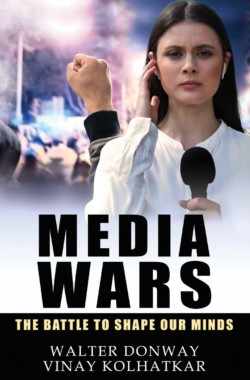The Falling Interest Game: Why Speculators Win and Business Loses
It is both impossible and undesirable, to expand a business which earns less than the bond interest rate.
Most people assume that prices move as a result of changes in the money supply. Instead, let’s look at the effect of changes in interest rates. To start, consider a hypothetical hamburger restaurant, MacDowell’s. Suppose that the average profit in the burger business is ten percent of invested capital. If MacDowell’s is thinking about expanding, it has to consider the interest rate. Why?
Typically, most of the capital to expand a business is borrowed. MacDowell’s has to borrow the cash to build out its new store. If the cost of capital is greater than the return on capital, then it makes no sense to expand. Let that sink in, because it is vitally important. You cannot borrow at 10% to earn 8%.
Of course not all of the capital is borrowed. MacDowell’s also puts up some of its own funds (or at least it would in a normal world without a central bank drowning the markets with liquidity). The company has to consider what else it could do with that cash. If it could earn more on a bond portfolio, why should it take business risk? Let this sink in also. You should not invest in business equity to earn less than the yield on bonds.
We have just looked at two connections between interest and profit margins. It is both impossible and undesirable, to expand a business which earns less than the bond interest rate. Now let’s look at the connection in the other direction. MacDowell’s profit-seeking behavior actually affects interest.
What happens to the interest rate if MacDowell’s borrows at two percent to build a hamburger stand that makes ten percent? The very act of borrowing pushes up the interest rate slightly (in a normal world). The very act of opening another hamburger store pushes down the rate of profits on hamburger stores.
To make it simple, let’s assume that the rate of interest goes up to three and the rate of profit comes down to nine. That’s still pretty attractive, so Burger Emperor another chain, also opens up a store. Interest is pushed up to four, and profit pulled down to eight. And so on, until the next would-be burger baron walks away. Certainly, if the rate is six and profit is six, then no one else will want to enter this business. The same process happens in every industry.
The main concern by both Fed defenders and foes alike is the worry that prices might rise. Well, prices aren’t rising now. So the former are smug and the latter are frustrated. They miss the real harm of zero interest.
Today, of course the central banks pin the interest rate down. So MacDowell’s and Burger Emperor’s borrowing do not push up the interest rate. However, they still do pull down the rate of profit. They will keep adding to the burger supply, until the rate of profit is just above the Fed-administered interest rate.
Monetary policy claims to try to affect consumer prices—but it’s working its deadly effect on profits. Interest rates can’t go up, but profits can come down.
It turns out that this monetary policy does affect prices, though not in the way predicted by mainstream theory. Suppose Wednesday’s is the last burger business to borrow, the last to pull the rate of profit as close as possible to the rate of interest. How is Wednesday’s supposed to make this work? Worse yet, how is Burger Emperor staying alive with its higher interest rate, and McDowell’s with its even-higher rate?
They are locked in a desperate scramble to squeeze out every cost. They develop processes to make do without inventory, depending on just-in-time delivery. They automate and lay off as much labor as possible. Executives fly coach if they get a travel budget at all. They redesign their packaging to be cheaper, etc..
I don’t normally use the term unintended consequences. I prefer to discuss perverse outcomes, rather than emphasize the policy-makers’ real or declared intentions. However, in this case I think it’s safe to say that the Fed is getting the opposite of what it intends. It wants prices to rise by 2 percent. What is it actually getting?
Just look at the wreckage in the crude oil, copper, or even wheat markets. Prices are plummeting.
The Fed’s goal to get consumer and commodity prices rising at 2 percent per year is not being met. Its main goal, however, is to get the economy booming. It only wants prices to rise because it thinks that’s the way to get the economy kick-started.
So what are the effects of the Fed’s interest-rate policy on the real economy? Let’s look at the origin of interest to gain some insight. Once upon a time, before banks and before even private lending, there was only one way to prepare for retirement. People had to hoard something durable. Every week, they would set aside part of their wages to buy salt (later, it was silver). Assuming it didn’t get wet, the salt accumulated until they couldn’t work any longer. Then, they would begin selling it off to buy groceries. This was the best they could do. By modern standards, it wasn’t a very good method. Stockpiling a commodity does not finance business growth, so the hoarder contributed no capital to the economy. And, it carries a very big risk: what if you run out before you die? The development of lending was a revolutionary breakthrough.
Lending allowed the retiree to do business with the entrepreneur. The retiree has wealth, but no income. The entrepreneur has the opposite position, with income but no wealth. The retiree lets the entrepreneur use his wealth, in exchange for an income. The entrepreneur is happy to pay interest, in order to grow his business and increase profits. It’s a win-win.
And yet, at times throughout the centuries, governments prohibited lending at interest. They called it a pejorative name—usury. Sometimes, people could work around the law, but when they had to comply, lending ceased. No one will risk his wealth, or even forego possession of it, without getting something in return.
Today lending is not illegal, but the Fed has been driving down interest for over three decades. Its administered short-term rate is basically zero. Central bank apologists assert that this will help the economy. It hasn’t yet, and it never will. However, the main concern by both Fed defenders and foes alike is the worry that prices might rise. Well, prices aren’t rising now. So the former are smug and the latter are frustrated. They miss the real harm of zero interest.
Our economy is horribly weak, not in spite of the Fed’s policy, but because of it.
The Fed can force the rate to zero, but it cannot change economic law. As it chokes off interest, the sacred relationship between the saver and entrepreneur is breaking down. Lending to entrepreneurs is dying, and with it growth, opportunities, jobs, and new products. Our economy is horribly weak, not in spite of the Fed’s policy, but because of it.
Leaches never cured a fever, and zero interest is not curing the global financial crisis. If an exchange of wealth and income is not possible, what’s left? It’s replaced with the conversion of wealth to income. Move over, entrepreneur. We don’t need you anymore. Make way for the speculator. Instead of financing productive businesses, speculation is now the best way to make a profit.
But the falling interest game is not endless. The game must end, and when it does, the outcomes will be horrendous.
This article first appeared spread over two essays on Keith Weiner’s weekly column, called The Gold Standard, at the Swiss National Bank and Swiss Franc Blog SNBCHF.com.










